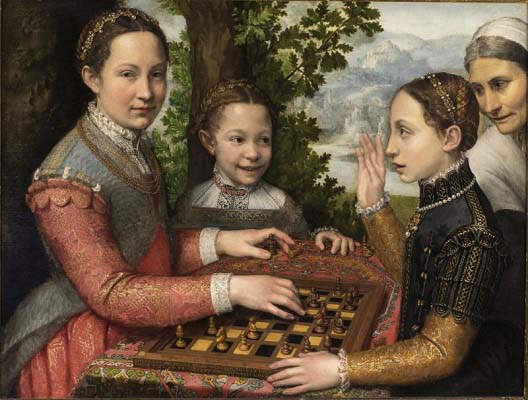Italy: Rediscovering women artists of the Renaissance

Rome: In his monumental Lives of the Artists Giorgio Vasari, the 16th-century chronicler of the painters of his century, devotes one chapter to women. He starts off with a flow of compliments regarding the creative abilities of women, in which he gallantly asserts that: “it is extraordinary that in all the skills and pursuits in which women in any period whatever have with some preparation been involved, they have always succeeded most admirably and have become more than famous, as countless examples could easily demonstrate.”
It is, however, a very short chapter, with only a handful of female artists cited, but in actual fact, a great number of women artists worked throughout the Renaissance and Baroque eras. In their day many were famous, with their own studios and apprentices. They obtained important commissions from prestigious patrons, including royals such as Charles I of Britain and Philip II of Spain. Some were also accepted as members of super-exclusive professional clubs such as the Academia di S. Luca in Rome and the Academia e Compagnia delle Arti del Disegno of Florence.
Almost all these women have been virtually forgotten in the intervening centuries, so much so that until modern times the visual arts were considered the exclusive domain of men.
Most women artists, like Tintoretto’s daughter, the talented Marietta, trained in their father’s studio, or else they came from aristocratic families, which allowed their daughters to study art along with the other necessary graces. Despite coming from these privileged backgrounds, however, many had to fight to make their way in the art world.
One of the main obstacles to the development of women artists of the time was that they were not admitted to life drawing classes, so they could not study the nude human body. As a result, most avoided subjects requiring a naked or scantily clad subject. Some got around it by getting family members to pose so that they could produce a dying Christ, a Greek Venus or a repentant Magdalene, but most preferred to stick to portraits, which were also a good source of income.
In his chapter on women, Vasari focuses largely on his contemporary, Properzia de’ Rossi, (1490-1530) the “Sculptress from Bologna” whom he describes as young, beautiful and talented as a musician, as well as “being skilful in household duties like any other woman.” He speaks lyrically of “the tender and lily-white hands” of women that “have not been ashamed…to place themselves in the mechanical arts between the roughness of marble and the harshness of iron …in order to attain their desire and to earn renown.”
Despite her tender and lily-white hands, Properzia worked in the all-male construction site of the Basilica of S. Petronio in Bologna, where she got a commission to carve a couple of angels, three Sybils and a pair of bas-relief panels. She defended her professional status literally tooth and nail, since she ended up in court for attacking and scratching one of her detractors. According to Vasari, in addition to sculpting marble busts for important clients, she was renowned for carving miniature biblical scenes and nativities on peach stones, which were much sought after by the nobility and frequently encased in jewellery.
Most of her output has been lost and the only one of her works which has been definitely identified is a bas-relief panel portraying the biblical story of Joseph rejecting the advances of Potiphar’s wife, where the woman’s face is thought to be a self portrait. Unfortunately, Properzia’s life seems to have ended sadly. She died at the age of 40, bankrupt and alone, and then sank into almost total oblivion during the following four centuries.
Lavinia Fontana (1552-1614), also from Bologna, was another determined character. She agreed to marry fellow artist Giovan Paolo Zappi only on condition that she would be allowed to carry on painting. Despite the subsequent birth of 11 children, she ran her own studio and supported her family, while her husband acted as her agent and looked after the home front. Lavinia was an elected member of the Academia di S. Luca. She specialised in portraits of the Roman nobility and Pope Paul V also sat for her. Perhaps her most poignant work is the portrait of the little Antonietta Gonsalvus, who was afflicted with the hereditary family condition of hypertrichosis or excessive hairiness. Since Antonietta was from an aristocratic family she did not end up as a circus freak, and Fontana’s skill produced a sympathetic image of a sweet child, despite her abundant facial hair. The painting is part of the collection of the Musée du Chateau de Blois.
Elisabetta Sirani (1638-1665) also came from Bologna, where she ran the family studio and a painting school for women. Her talent was widely recognised but she died young of suspected poisoning. She was buried in the Basilica of S. Lorenzo in the same tomb as Guido Reni, her father’s teacher. Rediscovered in the 1990s, she now has a crater on Venus dedicated to her, as well as a “first” for a woman artist in the form of a 1994 US postage stamp featuring her Madonna and Child.
Only keen art historians and discriminating frequenters of galleries and museums will be familiar with the works of Sophonisba Anguissola of Cremona (1532-1625), to whom Vasari dedicates almost an entire page. Vasari recounts that when she was still a child her father sent some of her drawings to Michelangelo who was most favourably impressed. Sophonisba was one of three sisters, “the noble and gifted sisters”, Vasari calls them, but she was the one to make her mark on the world as a court painter for Philip II of Spain. The famous portrait of Philip in the Prado, originally attributed to the Spanish maestro Alonso Sanchez Coello, is now believed to be her work. After 10 years working in Madrid, the king rewarded her with a high ranking husband from the Sicilian Moncado family and the couple moved back to Italy.
Later, when she was widowed, she fell in love with Orazio Lomellino, a ship’s captain several years her junior, and settled in Palermo, where she received distinguished visitors such as the acclaimed Flemish painter Anthony van Dyck. She died aged 93 and was buried in the Church of S. Giorgio dei Genovesi in Palermo. Her devoted husband inscribed on her tomb “….Sofonisba, my wife, who is recorded among the illustrious women of the world…..Orazio Lomellino in sorrow for the loss of his great love.”
The father of Diana Scultori from Mantua (1547-1612) was a sculptor and engraver and she learned her skills from him, despite the fact that printmaking was not considered a suitable occupation for a woman. However Diana was so talented that she was granted a special permit from Pope Gregory XIII to market her work. Vasari describes her as “a very gentle and gracious girl, and her works, which are most beautiful, struck (him) with amazement.” An astute businesswoman, she was the first woman artist to sign her name on her works – often calling herself “Diana Mantuana” or “Diana Mantovana.”
Many other women artists were nuns, where convent life allowed them to pursue their art untrammelled by domestic duties. Paolo Ucello’s daughter, Antonia Doni (1446-1491), for instance, was a Carmelite who produced exquisite miniatures. Sister Plautilla Nelli (1524-1588), also praised by Vasari, was the prioress of the convent of S. Caterina di Siena in Florence and is considered to be the first Florentine female artist. She taught herself by copying the drawings and paintings of the great masters and soon became flooded with commissions from the local noble families. Her works can be seen in the churches of S. Maria del Fiore and S. Giovannino.
Plautilla’s successful career probably inspired the talented noblewoman Lucrezia Quinistelli della Mirandola (1541-1594), also mentioned by Vasari. Unfortunately, her work has been lost. That is, all but one. In 2015, in the Church of S. Maria and S. Pietro at Silvano Pietra near Pavia, restorers made an exciting discovery under the grime-encrusted altar piece they were working on. It turned out to be the remarkable “Mystic Marriage of St Catherine” complete with Quinistelli’s signature on the stone under the Virgin’s foot.
Taking the veil was often the only alternative for girls whose families, for one reason or another, could not or would not stump up a suitable dowry. Orsola Maddalena Caccia (1596-1676) was the daughter of the artist Guglielmo Caccia, known as “Il Moncalvo” after his home town in the province of Asti. Caccia consigned all six of his daughters to the Ursuline convent of Brianza but his main motive was probably regard for their safety. The Brianza of the time was a fortified outpost stuck between the lands of the warlike Gonzago family, the Dukes of Mantua and Monferrato and the Duchy of Savoy, where aggressive rival bands were often on the rampage.
However, Caccia missed his daughters so much that he petitioned for permission to build a new Ursuline convent near him at Moncalvo, paying for it with his own money. Only two of the girls became artists but Orsola, in particular, became a much respected painter of religious themes. Appointed abbess in 1627, she set up an art school in the convent and a business selling the sisters’ works and continued to paint until well into her 70s.
Giovanna Garzoni (1600-1670) who worked for the Medici family, was famous for her still lifes and her work was so sought after that she could command her own prices.
Vasari died some 20 years before the birth of Artemisia Gentileschi (1593-1653) the only woman artist from the 17th century who could be called a household name today and even then her fame is due more to her turbulent personal history than to her undoubted talent. She was virtually forgotten until last century, when she was “discovered” by the critic Roberto Longhi in 1901 and subsequently became an icon of the feminist movements of the 1960-70s.
Raped by her father’s friend and collaborator Agostino Tassi, she steadfastly upheld her accusations in the Roman courts where she was even subjected to torture in an attempt to make her retract. She won her case, but her triumph was only partial. Tassi was given a nominative sentence of exile, which was never enforced and Artemisia herself was rushed into a marriage of convenience by her father to “save her honour.” Nonetheless, she went on to have a brilliant career, working at the Spanish court, and was the first woman to be accepted as a member of the Florentine Academy.
She moved in elevated intellectual circles, corresponding with people like Galileo and Leonardo Buonarotti, Michelangelo’s nephew, and meeting up with foreign artists such as Van Dyck and Rubens. She also worked in London for three years, at the royal court of Charles I, along with her father. However, she was forced to leave at the outbreak of the Civil War and return to Italy. She stayed in Naples for the rest of her life and may have died in the plague that hit the Neapolitan city in 1656, wiping out the greater part of the population.





